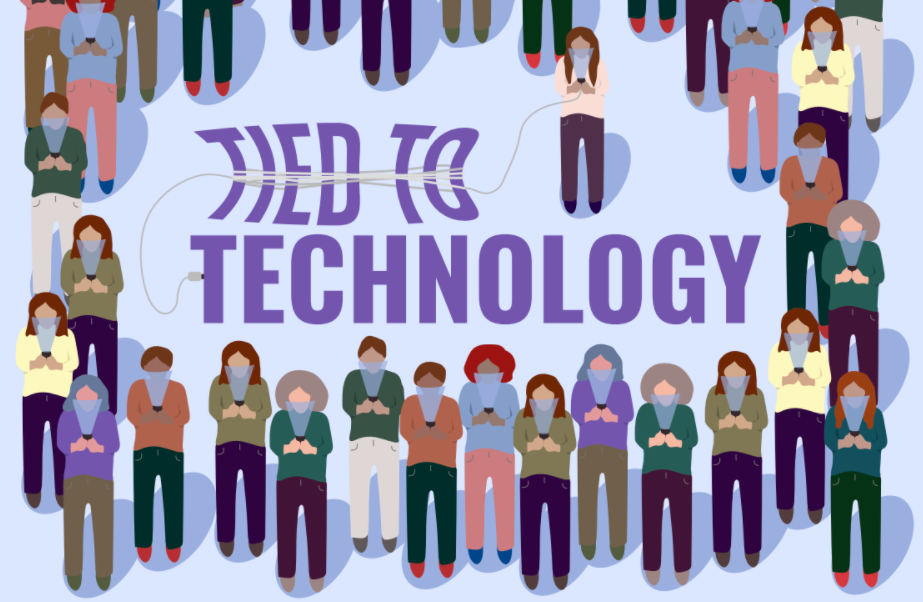Widespread addiction to technology threatens all aspects of teenagers’ lives
March 8, 2022
Upon walking into the commons during one of the lunch break periods, it’s not unusual to see a group of students sitting next to one another yet ignoring each other in favor of the glowing rectangle in front of them. This repeated action, commonly mistaken as a harmless quirk of Generation Z, has the potential to cause serious physical and mental health issues.
Tech’s Effects
In today’s world, phones control our everyday lives, telling us which restaurants we are closest to, what products to buy and what music to listen to. Whatever reason we turn to our phones for, we often find ourselves doing so as a way to escape reality.
According to science teacher Ryan Johnston, technology has the potential to be both helpful and a hindrance, especially for younger generations.
“I use [technology] if it makes my life better overall,” Johnston said. “If it doesn’t, I cut it out of my life entirely. Young people are more receptive to technology because technology is new and so are young people. Young people inherently don’t have the experience and prejudice that older people have. This is also why they solve so many problems that older people can’t. It’s a double-edged sword.”
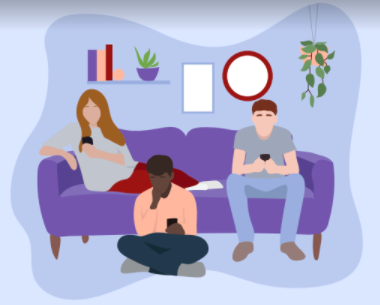 Freshman Lilly Rugenstein believes our devices provide people with new connections.
Freshman Lilly Rugenstein believes our devices provide people with new connections.
“Connection wise, [technology has] pretty much everything [you need] to know what’s going on in the other part of the world,” Rugenstein said. “Some of my friends moved to Texas so I communicate with them better [through technology]. I don’t really look at social media a lot and, if I do, I’m looking at what people are doing, not worrying about [things] like, “oh, I should do that.”
Psychology teacher Kirsten Crandall explains how technology is addictive by design. “The tech that most young people are addicted to is profitable for someone, despite how it might seem,” Crandall said. “The free apps [i.e. Instagram, Twitter] and games make someone money, the longer you are on them. So this technology is designed to keep you engaged and coming back as much as possible. To do so, they employ several strategies; social pressure, operant/classical conditioning and schedules of reinforcement and physical dependency.”
In order to make time for her hobbies, sophomore Kaylen Hyde attempts to keep her screen time down.
Like Rugenstein, Hyde uses her phone to stay connected with her loved ones.
“I read a lot, that is my main thing,” Hyde said. “I read a lot of romance and mystery, or I help with my mom’s daycare after school or, sometimes, I’ll draw. Little things like that get me away from my phone. I always have [my phone] by me just to have it near me because it’s important to me. Especially with having family, I want to try to respond to them right away because they’re my family. I always have it beside me, but I’m not always on it.”
Crandall says young adults enjoy social media because of its ability to provide instant gratification.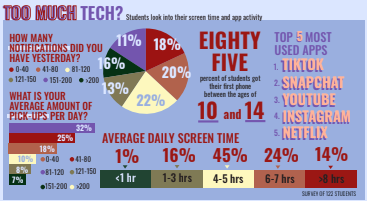
“There are many components that make technology addictive to young users,” Crandall said. “This is especially true of technology centered around social media. One reason this appeals to young minds so significantly is that this technology offers instant gratification in an arena of life that is always the top priority for this age group. “Developmentally, teenagers care most about their connection to and approval from their peers.”
Technology in School
Although technology is viewed as a beneficial tool in today’s society, its imprint on our professional lives, whether that be school or work, has made functioning without it nearly impossible.
Johnston, who considers time away from technology “a nice vacation,” believes the insertion of technology into our professional lives will only gradually heighten our addiction in the future.
“The addiction will only increase. There are thousands of people whose sole job is to draw your attention to a screen. And they are very good at it,” Johnston said. “They have sold devices to parents who in turn used them as digital pacifiers. And now these
devices are glowing life preservers in a sea of existential meaninglessness to hundreds of millions of young people. These devices have grown to be as much a part of children’s nervous systems as spinal cords.”
 Crandall views the usage of technology in jobs and school curriculum as something necessary and valuable in order to move forward in a rapidly developing world. However, she still strives to prevent spending unnecessary time using her devices.
Crandall views the usage of technology in jobs and school curriculum as something necessary and valuable in order to move forward in a rapidly developing world. However, she still strives to prevent spending unnecessary time using her devices.
“As a psychology teacher, I see some of the dangers and negative potential,” Crandall said. “However, it is the way of the future and so many necessary and valuable resources exist there. I actively work to have set time frames for what technology I use. For
example, I take a break from looking at any screen after 15 minutes of consistent use. I’ll read something instead, make a phone call, look outside, etc.”
In addition to using tech in the professional world, students have found it increasingly difficult to distance themselves from screens when all of their classwork exists within a laptop. For Hyde, the prospect of digital schoolwork has led her to believe that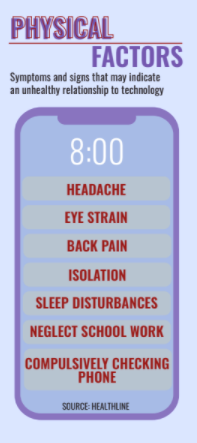 technology will soon dominate every aspect of our lives.
technology will soon dominate every aspect of our lives.
“Now more than ever, because we’ve started doing more stuff on laptops instead of on paper, I feel like it’s harder to step away from a screen even if I wanted to because, eventually, it’ll be where education is almost all online except for math, because you can’t do math online,” Hyde said. “But at some point, I feel like technology will just kind of take over the world and everything will have to do with technology at some point.”
 While not as concerned over technology taking a more domineering role in the future, Rugenstein feels that technology’s involvement in everything we do is reason to question our dependence on it going forward.
While not as concerned over technology taking a more domineering role in the future, Rugenstein feels that technology’s involvement in everything we do is reason to question our dependence on it going forward.
“I’d say [technology] isn’t necessarily destroying our lives even though many people might say that,” Rugenstein said. “I’d say [technology] adds to [life], but too much can ruin it. There’s a fine line that is now a bit shady or blurred because of how often it is used now.”
Away with addiction
It is not easy to refer to what we as a society have as an “addiction.” The word seems too sterile and clinical to describe what’s happening to our brains in the smartphone era. Someday we may learn to live in harmony with the portable supercomputers that
satisfy our every need and provide us with infinite amounts of stimulation. But for many, that proper balance of time spent on and off of our screens hasn’t happened yet. However, there are steps one can take to improve their relationship with technology.
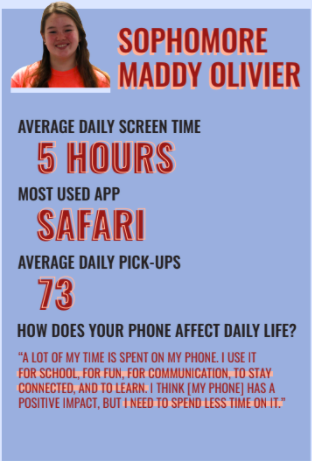 Crandall explains how one can take small steps in order to wean themselves from the constant need to look at a device.
Crandall explains how one can take small steps in order to wean themselves from the constant need to look at a device.
“If a person feels they spend too much time on technology or that an aspect of it is negatively impacting their mental health they should take small steps,” Crandall said. “Drastically deciding to quit apps or limit it down by anything over 30% simply won’t work. So instead, say you’re going to go through and unfollow two accounts that have a tendency to make you feel anything but better.”
Hyde believes that her hobbies help her keep her screen time down on her personal devices.
“I’ll have my phone by me and maybe answer a text while I’m reading, but I read for a couple hours sometimes or 30 minutes,” Hyde said. “I do a lot of my schoolwork
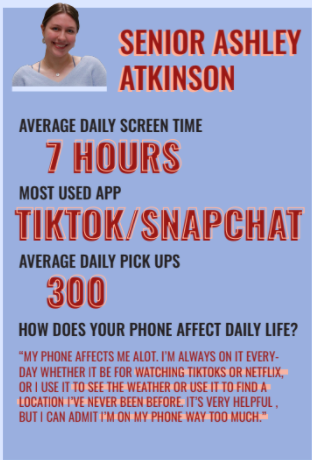 which takes time away from my phone and I’ll draw and stuff like that.”
which takes time away from my phone and I’ll draw and stuff like that.”
Rugenstein also enjoys drawing when trying to reduce her screen time, but explains how she still remains connected to technology when doing so.
“I like to draw. But then again, I write on the computer what I draw without it so [I’m] still connected, in a sense,” Rugenstein said.
For Johnston, it is important to recognize that society has become dependent on technology that sometimes causes more problems than it solves.
“At this point we are using technology to solve problems that technology created. It is a dangerous cycle,” Johnston said. “I don’t know how humanity will get out of it because the majority of humanity is soft flesh that dies without central heating and cooling. I don’t exclude myself from this population.”
